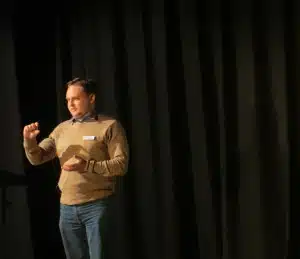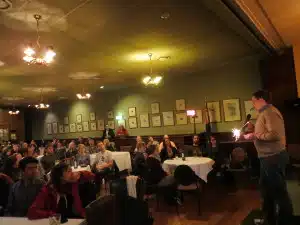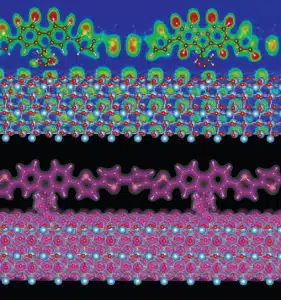
Daniel talking to students about nanoparticles at the Melbourne Museum
Size matters – just ask a nano-scientist. The discovery of inefficiencies at a nano-level by RMIT researchers could improve solar cells of the future.
The next generation of solar cells will have titanium dioxide nanoparticles coated in sunlight-sensitive dyes, helping them to catch more sunlight, Research Officer Daniel Drumm says.
Tiny titanium dioxide particles have different kinds of ‘faces’ with different properties – imagine the black and white faces on a soccer ball.
Using the ANU Supercomputer Facility, Daniel and his colleagues found that the dyes only sit on one of these types of face – but the opposite to what was assumed – which may have a huge effect on efficiency when used in solar panels.
“The models show that the dyes are only sitting on the uncommon ‘black’ faces, so at least 50 per cent of the surface area has no dye,” Daniel says.
“Further, the dye should catch sunlight more easily if it can be put on the ‘white’ faces, for a potential double win in efficiency.”
Daniel says it was assumed that dye stuck to the white faces only.
“So, by thinking really small – about little bits of the nanoparticles and how they interact with the dye – we have found a way to improve the solar technology that nobody has been looking at.
“If this solar cell can be improved, what about all the similar ones developed in the last 20 years?”
The nanoparticles (about 5000 times smaller than a human hair) self-assemble with the dye, making them cheaper to manufacture. These materials will also make solar cells much lighter and cheaper than those currently using silicon, which is heavy and expensive.
Daniel presented his research at Fresh Science Victoria 2015.
Fresh Science is a national program that helps early-career researchers find and share their stories of discovery. Over 30 early-career researchers nominated for Fresh Science Victoria, which was held at Scienceworks (training), Melbourne Museum (schools forum) and the Kelvin Club (public challenge event).
Fresh Science Victoria was supported by Museums Victoria, Bio-Medical Research Victoria and the Office of the Victorian Lead Scientist.
Contact:
Daniel Drumm
RMIT University
+61 3 9925 2547; daniel.drumm@rmit.edu.au,

Bright spark: Daniel presents at Fresh Science in the pub

Bright spark: Daniel presents at Fresh Science in the pub






 Fresh Science is on hold for 2022. We will be back in 2023.
Fresh Science is on hold for 2022. We will be back in 2023.